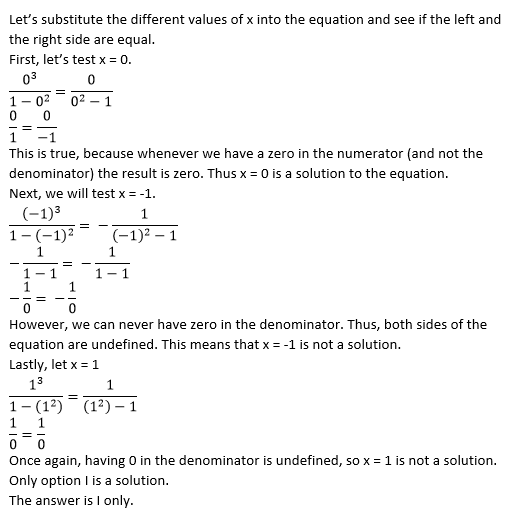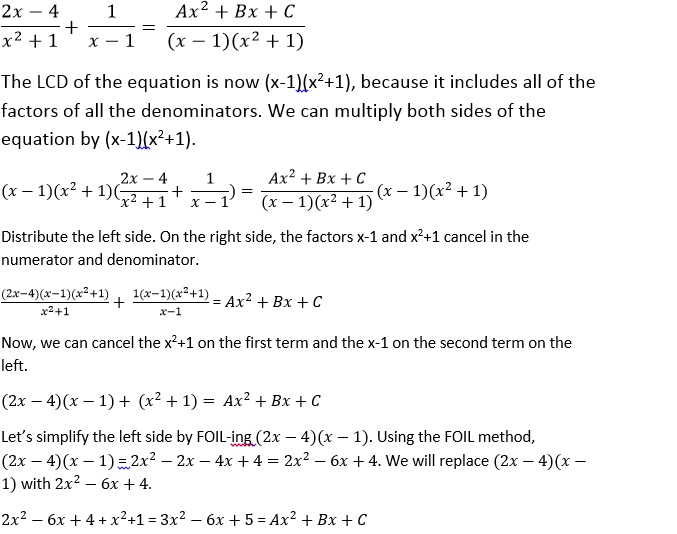Equations / Inequalities - ACT Math
Card 0 of 2799
Find the solution to the following equation if x = 3:
y = (4x2 - 2)/(9 - x2)
Find the solution to the following equation if x = 3:
y = (4x2 - 2)/(9 - x2)
Substituting 3 in for x, you will get 0 in the denominator of the fraction. It is not possible to have 0 be the denominator for a fraction so there is no possible solution to this equation.
Substituting 3 in for x, you will get 0 in the denominator of the fraction. It is not possible to have 0 be the denominator for a fraction so there is no possible solution to this equation.
Compare your answer with the correct one above

I. x = 0
II. x = –1
III. x = 1
I. x = 0
II. x = –1
III. x = 1
Compare your answer with the correct one above
Compare your answer with the correct one above
Given the following system, find the solution:
x = y – 2
2x – 2y = 2
Given the following system, find the solution:
x = y – 2
2x – 2y = 2
When 2 equations in a system have the same slopes, they will either have no solution or infinite solutions. Since the y-intercepts are not the same, there is no solution to this system.
When 2 equations in a system have the same slopes, they will either have no solution or infinite solutions. Since the y-intercepts are not the same, there is no solution to this system.
Compare your answer with the correct one above
A fraction is considered undefined when the denominator equals 0. Set the denominator equal to zero and solve for the variable.


A fraction is considered undefined when the denominator equals 0. Set the denominator equal to zero and solve for the variable.
Compare your answer with the correct one above
 Solve for
Solve for  .
.


Cross multiplying leaves  , which is not possible.
, which is not possible.
Cross multiplying leaves 
Compare your answer with the correct one above
Solve:

Solve:
First, distribute, making sure to watch for negatives.


Combine like terms.

Subtract 7x from both sides.

Add 18 on both sides and be careful adding integers.

First, distribute, making sure to watch for negatives.
Combine like terms.
Subtract 7x from both sides.
Add 18 on both sides and be careful adding integers.
Compare your answer with the correct one above
Solve:

Solve:
First, distribute the  to the terms inside the parentheses.
to the terms inside the parentheses.


Add 6x to both sides.

This is false for any value of  . Thus, there is no solution.
. Thus, there is no solution.
First, distribute the 
Add 6x to both sides.
This is false for any value of 
Compare your answer with the correct one above
Solve for  :
:

Solve for 

Like other "solve for x" problems, to begin it, the goal is to get x by itself on one side of the equals sign. In this problem, before doing so, the imaginary -1 in front of (-27x+27) must be distributed.

Once this is done, you may start to try to get x by itself.

However, when subtracting 27x from either side and doing the same on the other, the 27x term cancels out. As a result, the equation becomes:

We know this is an untrue statement because these numbers are 5 spaces away from each other on the number line. The final answer is No Solution.

Like other "solve for x" problems, to begin it, the goal is to get x by itself on one side of the equals sign. In this problem, before doing so, the imaginary -1 in front of (-27x+27) must be distributed.
Once this is done, you may start to try to get x by itself.
However, when subtracting 27x from either side and doing the same on the other, the 27x term cancels out. As a result, the equation becomes:
We know this is an untrue statement because these numbers are 5 spaces away from each other on the number line. The final answer is No Solution.
Compare your answer with the correct one above
Given the following system, find the solution:


Given the following system, find the solution:
When two equations have the same slope, they will have either no solution or infinite solutions. By putting both equations into the form  , we get:
, we get:

and

With the equations in this form, we can see that they have the same slope, but different y-intercepts. Therefore, there is no solution to this system.
When two equations have the same slope, they will have either no solution or infinite solutions. By putting both equations into the form 
and
With the equations in this form, we can see that they have the same slope, but different y-intercepts. Therefore, there is no solution to this system.
Compare your answer with the correct one above
Solve the following equation for  :
:

Solve the following equation for 
In order to solve for  , we must get
, we must get  by itself on one side of the equation.
by itself on one side of the equation.

First, we can distribute the  on the left side of the equal sign and the
on the left side of the equal sign and the  on the right side.
on the right side.

When we try to get  by itself, the
by itself, the  terms on each side of the equation cancel out, leaving us with:
terms on each side of the equation cancel out, leaving us with:

We know this is an untrue statement, so there is no solution to this equation.
In order to solve for 

First, we can distribute the 

When we try to get 

We know this is an untrue statement, so there is no solution to this equation.
Compare your answer with the correct one above
Solve  .
.
Solve 
By definition, the absolute value of an expression can never be less than 0. Therefore, there are no solutions to the above expression.
By definition, the absolute value of an expression can never be less than 0. Therefore, there are no solutions to the above expression.
Compare your answer with the correct one above
Compare your answer with the correct one above
In the equation below,  ,
,  , and
, and  are non-zero numbers. What is the value of
are non-zero numbers. What is the value of  in terms of
in terms of  and
and  ?
?

In the equation below, 





Compare your answer with the correct one above
Compare your answer with the correct one above
John, Jill, and Jack are splitting a pizza. John eats  of the pizza and Jill eats
of the pizza and Jill eats  of the pizza. How much of the pizza is left for Jack?
of the pizza. How much of the pizza is left for Jack?
John, Jill, and Jack are splitting a pizza. John eats 

We can write an equation for the amount of pizza eaten, with  as the amount left for Jack.
as the amount left for Jack.

To solve this equation, we must find the lowest common denominator of  and
and  . We can list the multiples of
. We can list the multiples of  and
and  to find the least common multiple:
to find the least common multiple:


We can see that the least common multiple of  and
and  is
is  , so we can rewrite each of the fractions with a denominator of
, so we can rewrite each of the fractions with a denominator of  .
.


When we put these fractions back into the equation, we can solve for  :
:



We can write an equation for the amount of pizza eaten, with 
To solve this equation, we must find the lowest common denominator of 



We can see that the least common multiple of 



When we put these fractions back into the equation, we can solve for 
Compare your answer with the correct one above
What is the slope of a line represented by the equation:

What is the slope of a line represented by the equation:
To solve problems where you need to find the slope of a line in a given equation, change the equation so that it matches y-intercept form:

For this equation, first move the 3x over to the other side of the equation.



The equation should now look like this:

Then, divide by 15 to isolate the variable  .
.

Then simplify

Whatever number is before the x in the equation (m) is your slope.

To solve problems where you need to find the slope of a line in a given equation, change the equation so that it matches y-intercept form:
For this equation, first move the 3x over to the other side of the equation.

The equation should now look like this:
Then, divide by 15 to isolate the variable 
Then simplify
Whatever number is before the x in the equation (m) is your slope.
Compare your answer with the correct one above
If 6_x_ = 42 and xk = 2, what is the value of k?
If 6_x_ = 42 and xk = 2, what is the value of k?
Solve the first equation for x by dividing both sides of the equation by 6; the result is 7. Solve the second equation for k by dividing both sides of the equation by x, which we now know is 7. The result is 2/7.
Solve the first equation for x by dividing both sides of the equation by 6; the result is 7. Solve the second equation for k by dividing both sides of the equation by x, which we now know is 7. The result is 2/7.
Compare your answer with the correct one above
If 4_x_ + 5 = 13_x_ + 4 – x – 9, then x = ?
If 4_x_ + 5 = 13_x_ + 4 – x – 9, then x = ?
Start by combining like terms.
4_x_ + 5 = 13_x_ + 4 – x – 9
4_x_ + 5 = 12_x_ – 5
–8_x_ = –10
x = 5/4
Start by combining like terms.
4_x_ + 5 = 13_x_ + 4 – x – 9
4_x_ + 5 = 12_x_ – 5
–8_x_ = –10
x = 5/4
Compare your answer with the correct one above
If 3 – 3_x_ < 20, which of the following could not be a value of x?
If 3 – 3_x_ < 20, which of the following could not be a value of x?
First we solve for x.
Subtracting 3 from both sides gives us –3_x_ < 17.
Dividing by –3 gives us x > –17/3.
–6 is less than –17/3.
First we solve for x.
Subtracting 3 from both sides gives us –3_x_ < 17.
Dividing by –3 gives us x > –17/3.
–6 is less than –17/3.
Compare your answer with the correct one above













